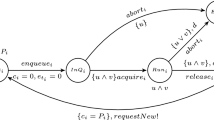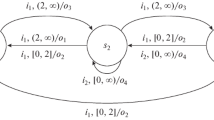Abstract
Synchronous reactive models are widely used in the development of embedded software and systems. The schedulability analysis of tasks obtained as the code implementation of synchronous finite state machines (FSMs) can be performed in several ways. One possible option is to leverage the correspondence between the execution of actions in an FSM and the execution of jobs in a digraph task model, thereby applying all the analysis methods developed for these digraph task systems. Another option is to directly leverage the state information and use dynamic programming methods to compute the worst possible sequence of (state dependent) reactions for a given FSM model. In this paper we compare these analysis methods in terms of accuracy and runtime.

























Similar content being viewed by others
References
Baccelli F, Cohen G, Olsder GJ, Quadrat JP (1992) Synchronization and linearity: an algebra for discrete event systems. Wiley, Hoboken
Baruah SK (2003) Dynamic-and static-priority scheduling of recurring real-time tasks. Real Time Syst 24(1):93–128
Di Natale M, Zeng H (2012) Task implementation of synchronous finite state machines. In: Proceedings of the conference on design, automation, and test in Europe, pp 206–211
Esterel Technologies (2014) The Trusted Design Chain Company: scade suite. http://www.esterel-technologies.com/products/scade-system/
Fersman E, Krcal P, Pettersson P, Yi W (2007) Task automata: schedulability, decidability and undecidability. Int J Inf Comput 205(8):1149–1172
Floyd RW (1962) Algorithm 97: shortest path. Commun ACM 5(6):345
Gavalec M (2000) Linear matrix period in max-plus algebra. Linear Algebra Appl 307(1):167–182
Guan N, Gu C, Stigge M, Deng Q, Yi W (2014) Approximate response time analysis of real-time task graphs. In: IEEE real-time systems symposium (RTSS), pp 304–313
Harel D (1987) Statecharts: a visual formalism for complex systems. Sci Comput Program 8(3):231–274
Hartmann M, Arguelles C (1999) Transience bounds for long walks. Math Oper Res 24(2):414–439
Lee EA, Varaiya P (2011) Structure and interpretation of signals and systems. Addison Wesley, Boston
Lehoczky JP (1990) Fixed priority scheduling of periodic task sets with arbitrary deadlines. In: 11th IEEE real-time systems symposium, vol 90, pp 201–209
Mathworks (1994) The mathworks simulink and stateflow user’s manuals. http://www.mathworks.com
Molnárová M (2005) Generalized matrix period in max-plus algebra. Linear Algebra Appl 404:345–366
Natale MD, Guo L, Zeng H, Sangiovanni-Vincentelli A (2010) Synthesis of multi-task implementations of simulink models with minimum delays. IEEE Trans Ind Inf 6(4):637–651
Norström C, Wall A, Yi W (1999) Timed automata as task models for event-driven systems. In: sixth international conference on real-time computing systems and applications, pp 182–189
Peng C, Zeng H (2018) Response time analysis of digraph real-time tasks scheduled with static priority: generalization, approximation, and improvement. Real Time Syst 54(1):91–131
Stigge M, Ekberg P, Guan N, Yi W (2011) The digraph real-time task model. In: 16th IEEE real-time and embedded technology and applications symposium, pp 71–80
Stigge M, Yi W (2012) Hardness results for static priority real-time scheduling. In: 24th Euromicro conference on real-time systems (ECRTS), pp 189–198
Stigge M, Yi W (2013) Combinatorial abstraction refinement for feasibility analysis. In: 34th IEEE real-time systems symposium (RTSS), pp 340–349
Stigge M, Yi W (2015) Combinatorial abstraction refinement for feasibility analysis of static priorities. Real Time Syst 51(6):639–674
Stigge M, Yi W (2015) Graph-based models for real-time workload: a survey. Real Time Syst 51(5):602–636
Tindell K (1994) Adding time-offsets to schedulability analysis. In: Department of Computer Science, University of York, Report No. YCS-94-221
Wilhelm R, Engblom J, Ermedahl A, Holsti N, Thesing S, Whalley D, Bernat G, Ferdinand C, Heckmann R, Mitra T, Mueller F, Puaut I, Puschner P, Staschulat J, Stenström P (2008) The worst-case execution-time problem: overview of methods and survey of tools. ACM Trans Embed Comput Syst 7(3):36:1–36:53
Young NE, Tarjant RE, Orlin JB (1991) Faster parametric shortest path and minimum-balance algorithms. Networks 21(2):205–221
Zeng H, Di Natale M (2011) Mechanisms for guaranteeing data consistency and flow preservation in autosar software on multi-core platforms. In: 6th IEEE international symposium on industrial and embedded systems, pp 140–149
Zeng H, Di Natale M (2013) Using max-plus algebra to improve the analysis of non-cyclic task models. In: 25th Euromicro conference on real-time systems (ECRTS), pp 205–214
Zeng H, Di Natale M (2015) Computing periodic request functions to speed-up the analysis of non-cyclic task models. Real Time Syst 51(4):360–394
Zeng H, Natale MD (2012) Schedulability analysis of periodic tasks implementing synchronous finite state machines. In: 24th Euromicro conference on real-time systems (ECRTS), pp 353–362
Zhao Y, Peng C, Zeng H, Gu Z (2017) Optimization of real-time software implementing multi-rate synchronous finite state machines. ACM Trans Embed Comput Syst 16(5s):175:1–175:21
Zhu Q, Deng P, Di Natale M, Zeng H (2013) Robust and extensible task implementations of synchronous finite state machines. In: Design, automation test in Europe conference exhibition (DATE), pp 1319–1324
Acknowledgements
This paper is partially supported by NSF Grant Nos. 1739318 and 1812963.
Author information
Authors and Affiliations
Corresponding author
Additional information
Publisher's Note
Springer Nature remains neutral with regard to jurisdictional claims in published maps and institutional affiliations.
Rights and permissions
About this article
Cite this article
Peng, C., Zeng, H. & Natale, M.D. A comparison of schedulability analysis methods using state and digraph models for the schedulability analysis of synchronous FSMs. Real-Time Syst 55, 598–638 (2019). https://doi.org/10.1007/s11241-019-09331-1
Published:
Issue Date:
DOI: https://doi.org/10.1007/s11241-019-09331-1




